 One of the main constraints to stemming the surge of bed bugs has been a lack of effective residual insecticides. While the industry is blessed with efficacious materials for managing most indoor pests, bed bugs are another story. Given that they pierce and suck blood, baits are not an option at least in their current forms. Various dusts are effective, but there are limits to where they can prudently be applied. Several sprays and aerosols kill bed bugs contacted directly, but lose their potency after the application has dried. Consequently they have negligible effects on any bed bugs and eggs that are overlooked, or re-introduced as hitchhikers or through migration from nearby units in multifamily housing or public accommodations.
One of the main constraints to stemming the surge of bed bugs has been a lack of effective residual insecticides. While the industry is blessed with efficacious materials for managing most indoor pests, bed bugs are another story. Given that they pierce and suck blood, baits are not an option at least in their current forms. Various dusts are effective, but there are limits to where they can prudently be applied. Several sprays and aerosols kill bed bugs contacted directly, but lose their potency after the application has dried. Consequently they have negligible effects on any bed bugs and eggs that are overlooked, or re-introduced as hitchhikers or through migration from nearby units in multifamily housing or public accommodations.
Most of today’s residual insecticides used to combat bed bugs are pyrethroids. Their effectiveness in the field has generally been inconsistent, and lab studies suggest resistance is prevalent throughout the country (Romero et al. 2008, Zhu et al. 2010). It’s becoming apparent that bed bugs have a formidable arsenal of mechanisms to de-activate insecticides, including target site (nerve) insensitivity, metabolic detoxification and reduced penetration of insect cuticle. What makes this concerning is that there are few residually effective insecticides today with differing modes of action against bed bugs. Phantom (chlorfenapyr) is one, although the liquid formulation is relatively slow acting and often combined with faster-acting materials.
Enter Temprid/Transport. A recent trend in pesticide manufacturing is the development of products with dual-active ingredients. The main intents are to broaden activity against a greater number of target pests, and increase effectiveness against hard-to-control ones like bed bugs. Temprid (Bayer CropScience LP) and Transport (FMC Corp.) are two such products being used by a growing number of pest controllers (Potter et al. 2011). Each contains a pyrethroid plus neonicotinoid [(Temprid: ß-cyfluthrin + imidacloprid) and (Transport: bifenthrin + acetamiprid)] in their formulations. Because pyrethroid and neonicotinoid insecticides have different modes of action, the hope is that the combination of ingredients produces superior results against pyrethroid-resistant populations.
 Figure 1. Cumulative effect on a resistant bed bug strain exposed to Temprid as a direct spray and freshly dried deposit (on wood). Dry residue results were similar on fabric. Figure 1. Cumulative effect on a resistant bed bug strain exposed to Temprid as a direct spray and freshly dried deposit (on wood). Dry residue results were similar on fabric. |
Laboratory Tests. A series of experiments were conducted to evaluate Temprid and Transport on bed bugs having varying levels of resistance to pyrethroids. The products were evaluated similarly but independently of each other, i.e., at different times in separate studies.
 Bed bugs exposed to Temprid and Transport often displayed pre-lethal effects. The bug with legs askew (top) was treated with Temprid. Bed bugs exposed to Transport (bottom) often exhibited a “ballooning” response caused by sucking air into the gut. Bed bugs exposed to Temprid and Transport often displayed pre-lethal effects. The bug with legs askew (top) was treated with Temprid. Bed bugs exposed to Transport (bottom) often exhibited a “ballooning” response caused by sucking air into the gut. |
Temprid — Temprid was evaluated on two different bed bug populations, one collected from Cincinnati (CIN-1), previously determined to be pyrethroid-resistant, and another collected from Los Angeles (LA-1) deemed pyrethroid susceptible. In one trial, adults from each colony (three replicates of 10 bugs, half males, half females) were sprayed directly with Temprid SC (0.075%), Suspend SC (0.06% deltamethrin) or water alone. After treatment, the sprayed bed bugs were immediately removed to a clean container to observe mortality. In a second experiment, the same treatments were applied to mattress fabric or wood (Masonite) and allowed to dry before adult bed bugs were placed on each substrate. Residual effects were evaluated by confining the bugs continuously on the dry deposits. In a third experiment, Temprid deposits were aged for extended periods up to six months. Adults (four replicates of 10 bugs) were confined on each aged deposit and observed for subsequent effects.
Transport — Transport was evaluated against the susceptible (LA-1) and resistant (CIN-1) populations, plus a third, highly resistant bed bug strain originating from New York (NY-1). Adult bed bugs (four replicates of 10 bugs) were sprayed directly with either Transport GHP or Mikron (0.11%), Suspend (0.06%) or water. Similar groups of bugs were exposed continuously to recently dried deposits.
Lab Results. The outcome of various experiments is shown in Figures 1-4. Both Temprid and Transport were consistently more effective in killing bed bugs than the pyrethroid Suspend (deltamethrin) alone. This was especially true vs. the resistant populations CIN-1 and NY-1. Effects generally were most rapid when the products were sprayed directly onto the insects. Sick and dead individuals were evident within one hour of direct treatment with both combination products, whereas deltamethrin killed more slowly, even on the susceptible (LA-1) strain. Sick bed bugs seldom recovered, and their uncoordinated movements and abnormalities suggested they would be unlikely to feed. Control mortality (from treatment with water alone) was very low in all experiments.
Especially significant was the enhanced effectiveness of Temprid and Transport dry (residual) deposits. High levels of mortality were attained with the CIN-1 resistant strain, with both products performing better than deltamethrin. In the extended residual test with Temprid, high mortality occurred even when bed bugs were exposed to wood and fabric surfaces treated six months earlier (see Figure 2 below). Although Transport was not evaluated in this manner, similar long-term effects from dried deposits were observed and reported previously with Phantom (Romero et al. 2010). Prolonged effectiveness of these materials as dry deposits should help eliminate bugs and eggs overlooked or re-entering dwellings.
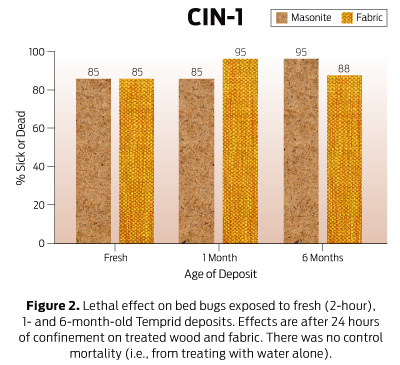
Nonetheless, some bed bug populations treated with these products will be harder to kill than others. Transport was very effective against the highly resistant NY-1 strain as a direct spray, but clearly less so as a dry deposit (see Figure 4 below). While 100 percent and 80 percent of bed bugs from LA-1 and CIN-1 strains succumbed within 24 hours of exposure to Transport (Mikron) dry deposits, only 13 percent of NY-1 bugs died during the same period. A higher percentage of NY-1 bed bugs were eventually impacted by dry deposits of Transport GHP compared to Transport Mikron (suggesting formulation makes a difference), but only after longer periods of exposure. Conversely, 100 percent of bugs from the NY-1 strain succumbed in 24 hours when sprayed directly with both Transport formulations, underscoring the benefits of finding and directly treating aggregations whenever possible.
Field Trial. In 2010, 22 bed bug-infested apartment units in Cincinnati were selected for treatment with Temprid. The majority were located in different buildings around the city (four properties had two infested units each). Most of the apartments were rented by tenants in the low- to mid-income range.
 Each unit was inspected before initial treatment, recording numbers of live bed bugs (adults and nymphs) observed on beds, furniture, floors, walls, ceiling and other locations. Pretreatment infestation levels based on visual inspections varied from a low of 19 live bugs found in one apartment to more than 1,000 in another (four units had initial pre-treatment counts of 25 bed bugs or less, nine had 26 to 100, six had 101 to 300, and three had 301 to 1,024 bugs). Adjoining units were inspected and treated if necessary in a manner similar to test units.
Each unit was inspected before initial treatment, recording numbers of live bed bugs (adults and nymphs) observed on beds, furniture, floors, walls, ceiling and other locations. Pretreatment infestation levels based on visual inspections varied from a low of 19 live bugs found in one apartment to more than 1,000 in another (four units had initial pre-treatment counts of 25 bed bugs or less, nine had 26 to 100, six had 101 to 300, and three had 301 to 1,024 bugs). Adjoining units were inspected and treated if necessary in a manner similar to test units.
Prior to treatment, residents were asked to remove, bag and launder bed linens and clothing. Some complied with this request while others did not. Tenants were not asked to disassemble beds or dispose of bed bug-infested belongings. During the trial, one tenant did throw out a heavily infested headboard and another disposed of a moderately infested mattress and box spring. No encasements were installed on beds while insecticide treatments were being evaluated. Consequently, resultant changes in bed bug number were primarily due to application of the insecticide.
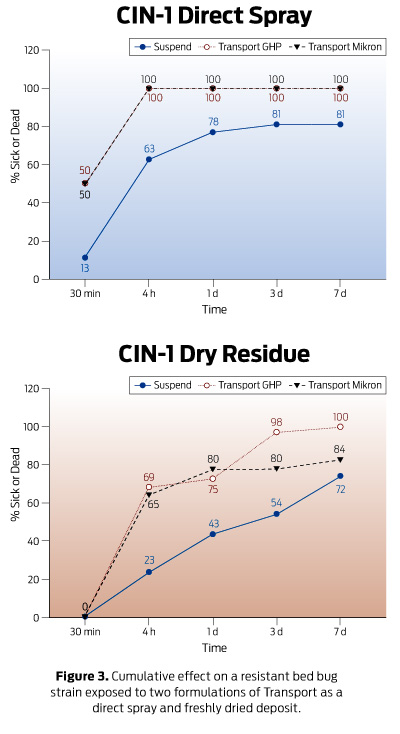
All 22 apartments were treated with Temprid SC (0.075 percent dilution) as the sole insecticide, i.e., no other liquids, aerosols or dusts were applied. Applications were thorough, targeting areas where bed bugs were found or likely to reside. This included along seams, folds, edges and crevices of mattresses, box springs, bed frames and headboards; along and beneath baseboards and molding; along seams, folds and crevices of upholstered furniture; at ceiling-wall junctures; and behind wall-mounted items. The average amount of Temprid applied per apartment on the initial service was 0.6 gallon (between 0.125 gallon and 1 gallon) whereas follow-up applications averaged about 0.25 gallon (between 0.125 gallon and 0.75 gallon).
Each apartment was inspected bi-weekly for up to 12 weeks. The number and location of live bed bugs was recorded on each visit, with three subsequent inspections made after no more bugs were found. Additional applications were performed as needed.
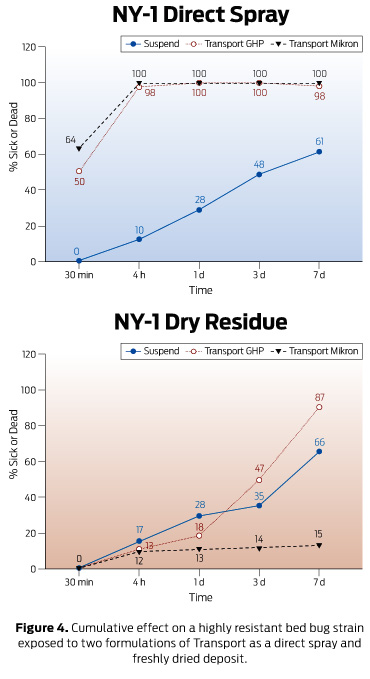
Field Results. As in previous apartment insecticide trials (Potter et al. 2006, 2008), beds harbored the most bed bugs observed. Prior to treatment, 61 percent of the bugs were found on the bed complex (29 percent mattresses, 20 percent box springs, 12 percent bed frames and headboards). Once again, couches and upholstered chairs supported the next largest share of bed bugs (20 percent) followed by walls and ceilings (7 percent), and baseboard areas (6 percent). Other places where bed bugs were found in the study included computer chairs, nightstands and dressers, drapes, door frames, wall outlets, items stored under beds, and behind pictures and bathroom shower heads, reinforcing the importance of comprehensive inspections.
As shown in Figure 5 below, treatment with Temprid caused a rapid decline in bed bug numbers. Compared to the average initial bed bug count per apartment (174), an 83 percent reduction was noted after two weeks, 94 percent fewer bugs were found after four weeks and 98 percent fewer after eight weeks. At the two-, four- and eight-week evaluations, 21, 10 and 8 apartments, respectively, continued to have live bed bugs while three units still had small numbers after 12 weeks. In about half the apartments, treatment was hindered at times by lack of preparation, clutter and poor tenant cooperation. Nonetheless the findings reinforce the need for follow up regardless of treatment method. In more than 25 percent of the apartments, live bed bugs were discovered after none were found on earlier inspections, illustrating the uncertainty in declaring accounts “bed bug free.”
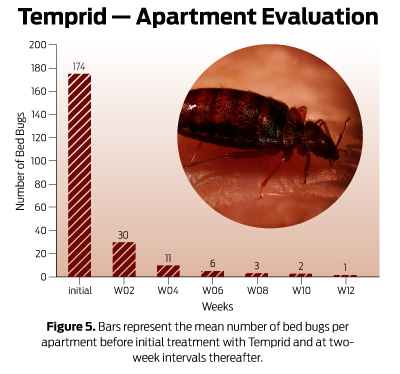
One-Two Punch. These results suggest that combination products containing pyrethroid-neonicotinoid ingredients are more potent bed bug killers than pyrethroids alone. In earlier studies with Temprid, we also found the dual formula to be more efficacious against bed bugs than either of its pyrethroid (cyfluthrin) or neonicotinoid (imidacloprid) ingredients alone.
Presumably the enhanced effect of Temprid and Transport is a consequence of their ingredients having two different modes of action. Like a heavyweight boxer, the combo formulations deliver a “one-two punch” to different target sites on the insect’s nerve cells. Nerve cells (neurons) are connected end-to-end like train cars. Between each is a small space (synapse) through which chemical signals flow. The neonicotinoid component disrupts transmission of these signals by binding to post-synaptic (acetylcholine) receptors between interconnected cells. The pyrethroid component delivers its “punch” along the length (axon) of the neuron, interfering with the flow of electrically charged sodium particles through tiny channels in the nerve. As a result, the effects of both compounds are intensified, including against bed bug strains that are resistant.
Treatment as Prevention? Thus far, insecticide use for bed bugs has been mostly curative, i.e., to control an existing infestation. With the extended potency of some of the newer materials, there also may be potential for preventive treatment, by making prescriptive applications to bed bug-prone locations. The aim would be to target specific areas where hitchhiking bed bugs are likely to first establish and “nip them in the bud” with the non-repellent residual deposit. In hotels, for example, ongoing inspection/monitoring of rooms might be supplemented with quarterly, semi-annual or perhaps even annual treatment behind headboards, under/along edges of box springs, bed frames, etc. Whether pre-emptive treatments would work in more cluttered environments such as homes, apartments, dorms and shelters, is unclear. Uncertainties relative to effectiveness and prudence of preventive applications would also need to be deliberated for accounts without beds (office buildings, theaters, public transportation, etc.). In all of the above cases, indiscriminate spraying of floors, walls and other surfaces coming in direct contact with occupants would be imprudent.
Prophylactic insecticide treatment especially indoors and in bedrooms tends to be controversial. Assuming it is effective, the greater the risk and consequences of infestation the more “valid” such measures become. Termites, cockroaches, fleas, ticks, fire ants and mosquitoes are examples of pests proactively managed in this manner, so why not perhaps bed bugs? Considering the hardship and misery they inflict, more research and discussion on prescriptive preventive treatment seems warranted.
Future Prospects. Feedback from pest control firms also suggests that the dual-action products are performing well against bed bugs. In a recent (2011) industry survey, Temprid and Transport were among the most mentioned insecticides being utilized for bed bug management. Notably, neither product made the “top 10” list of preferred materials the previous year (Potter et al. 2011).
As noted early on in this article, bed bugs have a history of becoming resistant to insecticides, and have the genetic capability to adapt to new chemical assaults. While Temprid and Transport are presently performing well in the field, companies should nonetheless be vigilant for hints of declining performance “down the road.” One possible indication might be bugs persisting on previously treated surfaces, especially after thorough and repeated applications. There is likely to be considerable variation amongst populations. Of course there are reasons other than resistance why bed bug infestations may be difficult to eradicate — including clutter and a lack of client cooperation, reintroduction of infested items, migration from adjoining units and the uncanny ability of this bug to hide almost anywhere.
The growing number of effective bed bug management tools affords us hope for the future. While such methods as heating, chilling, encasing, vacuuming, vigilance and early detection are important, insecticides are still a mainstay for providing affordable relief to the masses. The dual-action bed bug materials are among the best currently available.
Photos © M. F. Potter and K.F. Haynes
Michael F. Potter and Kenneth F. Haynes are professors at the University of Kentucky. Jennifer Gordon is a Ph.D. student at the same institution. Erich Hardebeck and Wayne Wickemeyer are president and service manager, respectively, of Permakil Pest Control, Covington, Ky. Funding for these studies was provided by Bayer and FMC.
References
Potter, M.F., K.F. Haynes, M. Henriksen and B. Rosenberg. 2011. The 2011 bed bugs without borders survey. PestWorld. Nov./Dec.: 4-15.
Potter, M.F., A. Romero, K.F. Haynes and W. Wickenmeyer. 2006. Battling bed bugs in apartments. Pest Control Technol. 34(8): 44-52.
Potter, M.F., K.F. Haynes, A. Romero, E. Hardebeck and W. Wickemeyer. 2008. Is there a new bed bug answer? Pest Control Technol. 36(6): 116, 118-24.
Romero, A., M. F. Potter, and K. F. Haynes. 2010. Evaluation of chlorfenapyr for control of the bed bug, Cimex lectularius L. Pest Management Science. 66: 1243-1248.
Romero, A. M.F. Potter and K.F. Haynes. 2008. Insecticide-resistant bed bugs: implications for the industry. Pest Control Technol. 35(7): 42-46.
Zhu, F., J. Wigginton, A. Romero, A. Moore, K. Ferguson, R. Palli, M.F. Potter, K.F. Haynes, and S.R. Palli. 2010. Widespread distribution of knockdown resistance mutations in the bed bug, Cimex lectularius (Hemiptera: Cimicidae), populations in the United States. Arch. Insect Biochem. Phys. 73: 245-57.
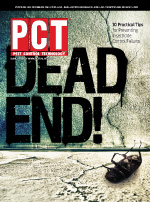
Explore the March 2012 Issue
Check out more from this issue and find your next story to read.
Latest from Pest Control Technology
- SiteOne Hosts 2024 Women in Green Industry Conference
- Veseris Celebrates Grand Reopening of the Miami ProCenter
- Rollins' 2024 Second Quarters Revenues up 8.7 Percent YOY
- Fleetio Go Fleet Maintenance App Now Available in Spanish
- German Cockroach Control Mythbusting
- Total Pest Control Acquires Target Pest Control
- NPMA Workforce Development Shares Hiring Updates
- Certus Acquires Jarrod's Pest Control





